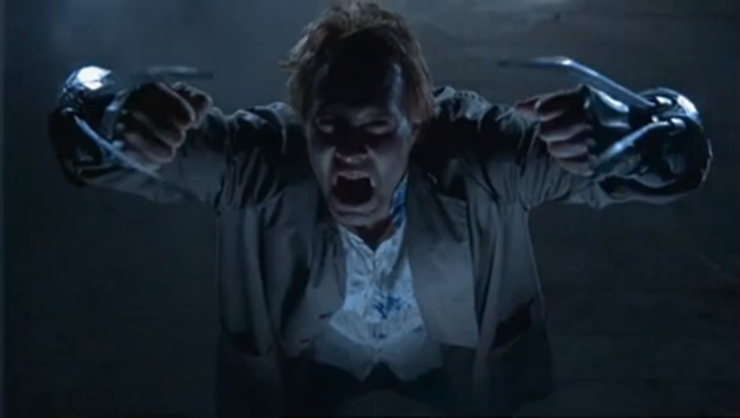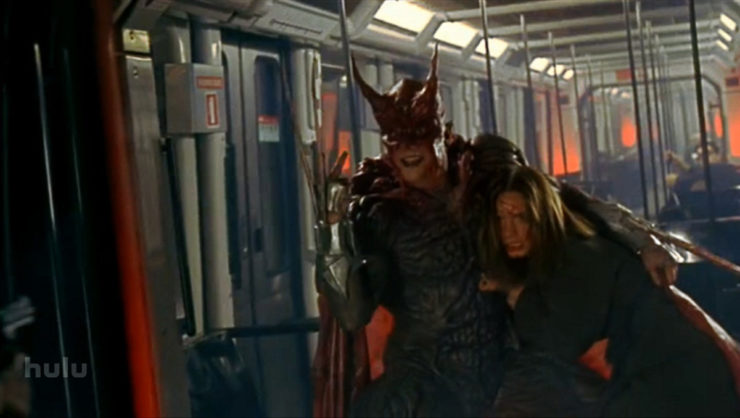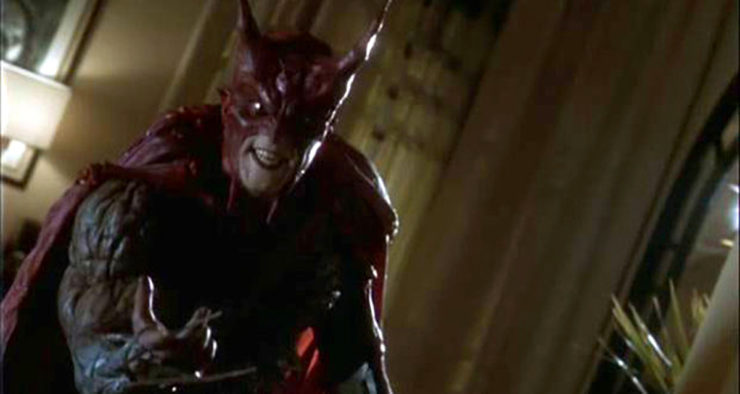From August 2017-January 2020, Keith R.A. DeCandido took a look at every live-action movie based on a superhero comic in the weekly “4-Color to 35-Millimeter: The Great Superhero Movie Rewatch.” He caught up to real time, as it were, with Joker in January, but now that we’re at the halfway mark of 2020, Keith has taken a look at the 2020 releases to date (Bloodshot and Birds of Prey earlier this month), and now examines the one movie he missed the first time through, 2000’s Faust: Love of the Damned.
Faust debuted in 1987 from David Quinn and Tim Vigil. Consisting of fifteen issues published by Rebel Studios and Avatar Press over the course of the next two-and-a-half decades, they finally concluded the main storyline in 2013. Telling the story of a man who sells his soul to the devil to become a killing machine, he rebels against the devil and fights back.
In 2000, the Barcelona-based company Filmax produced a film adaptation.
The comic book feels like a mix of Spawn and Wolverine, though the former actually came later. John Jaspers is meant to be a tool of a crime lord who goes by “M,” who is obviously supposed to be Lucifer (or Mephistopheles, whatever). After being transformed into a horned creature who wears gauntlets with huge claws that protrude from the wrists, Jaspers rebels. Also involved are a reporter named Balfour, who reports on the various killings going on, and Jaspers’ therapist and illicit lover, Jade De Camp.
The film adapts the basic story, though Balfour is replaced by a cop named Dan Margolies, and Jaspers is established as an artist who specifically was targeted for M after wanting to commit suicide following a gangster killing his girlfriend. He later meets De Camp after being institutionalized.
While Quinn wrote the screenplay based on his comic, Miguel Tejada-Flores has an “additional dialogue by” credit, though it’s unclear (one way or the other) what he contributed, precisely. Veteran horror meister Brian Yuzna (Bride of Re-Animator, Return of the Living Dead III, etc.) directed.
Mark Frost stars as the title character, with Jeffrey Combs (three different recurring characters on Star Trek and also a regular in Yuzna’s films) as Margolies, Mónica van Campen as M’s moll Claire, Isabel Brook as De Camp, and the great Andrew Divoff as M.
“I always knew deep inside that evil existed”
Faust: Love of the Damned
Written by David Quinn and Miguel Tejada-Flores
Directed by Brian Yuzna
Produced by Ted Chalmers, Carlos Fernández, Julio Fernández, Antonio González, Bea Morillas, Miguel Torrente, and Brian Yuzna
Original release date: October 12, 2000

Lieutenant Dan Margolies reports to a call at an embassy. SWAT has assembled, but are awaiting the arrival of Commissioner Marino. After hearing a scream, Margolies goes in anyhow, only to find nineteen badly mutilated corpses and a man cowering in the corner with huge claws on gauntlets on his wrists. Margolies thinks he’s about to die, but then the killer just stops when he sees a woman. Margolies sees the woman, too.
SWAT bursts in when Marino arrives. The cops find no sign of the woman, while Marino is pissed at Margolies for going in before he showed up.
The killer is institutionalized, and treated by Dr. Jade De Camp, who engages in music therapy. Margolies flirts creepily with her while also trying to get her to help him with the case. She politely deflects his flirting, but does take his card. She then tries to treat the patient with music, but he goes crazier at that, so she turns the music off. The head doctor, Yuri Yamato, tries to take her off the case. She goes to his file, only to discover that the hospital knows who he is, despite the case being a “John Doe.” He’s a man named John Jaspers. De Camp sneaks in to talk to him further. She learns that he was an artist. His girlfriend, Blue, was also his primary model. But she was smuggled illegally into the country and Baez, the gangster who facilitated her arrival, hasn’t been paid for his doing so. So Baez breaks in to the studio and kills her, trashing the place.
Jaspers is devastated, and wants to kill himself. As he stands on a bridge to jump off it, he’s approached by someone called M and a woman named Claire, who offer him a better choice: the power of despair to do whatever you want, in exchange for a soul he has no use for anyhow. Jaspers signs the contract, is given the gauntlets with the claws, and then kills Baez and his minions. Claire seduces him in the shower at one point (and also tries to conscript Jaspers to a rebellion against M), and Jaspers continues to kill on M’s behalf, including all the people in the embassy.
De Camp calls Margolies and says that the cops and the hospital know who he is, which pisses Margolies off. He agrees to meet her at a café.
Yamato works for M, however, and he kidnaps Jaspers from his cell and brings him to M, who buries him alive. However, he is transformed while in the grave into a horned creature and he crawls out of the ground.
M’s thugs try to kidnap De Camp while she’s waiting for Margolies, but Jaspers shows up, now with red skin and horns, and kills the thugs.
De Camp gets police protection at her house, and Margolies tells her to call him if she needs anything. After he leaves, she takes a bath, and has flashbacks to when she was raped at age eleven, but the face of her rapist is obscured.
Then Jaspers shows up, trying to convince De Camp that M has people everywhere, and to prove it, he kills one of her protection detail and wounds another. (It’s never actually clear if they’re dirty or not.) She throws a trench coat on over her nakedness (since she was just out of the bath) and runs to the subway, calling Margolies for help. A chase ensues on a subway train—which Margolies misses—and Jaspers kills several more cops, and absconds with De Camp, taking her back to his trashed studio.
There, they have sex, because apparently mass murder makes De Camp hot. (A trait she shares with Padmé Amidala…)
A thug returns to M to explain that Jaspers is somehow back from the dead. Claire has sex with him and kills him, which causes her to orgasm. M is livid that Jaspers is still around, and he also expands both Claire’s breasts and ass to monstrous proportions to remind her of her place.
Margolies suspects that Marino is dirty, given that he didn’t tell him that they knew Jaspers’s identity, and he tails the commissioner to M’s mansion, where he eavesdrops on a meeting of several powerful people in town, all of whom are about to engage in some manner of ritual to bring about hell on Earth. Marino is concerned about how public the nastiness is getting, and he’s getting pressure from the mayor. M’s response is to let a monster out from his chest to crush Marino’s head. Everyone else swears undying fealty to M.
However, using the thing in his chest takes a lot out of M, and Yamato has to give him medication to ease his suffering. Claire then seduces Yamato and convinces him to put something in his meds that will kill him so they can take over.
Margolies calls De Camp in her post-coital state (Jaspers is asleep, still) and says he’s snuck into M’s mansion and has a way to stop him, but she has to come help. She does so, only to find that Margolies has been turned by M.
Yamato injects M, who dies, but kills Yamato as well. Claire takes over, killing any underlings who don’t go along with her being boss now. She also dresses De Camp up in a chainmail bikini and starts torturing her, during which we discover that the one who raped her at age eleven was her own father.
In the midst of this, M resurrects himself and takes his power back. The ritual to summon the Homonculus and bring about hell on Earth starts, with both Claire and Margolies shaved and covered in gray gunk and De Camp lying on an altar, now with a sheer covering over her chainmail bikini.
Jaspers finally wakes up and realizes De Camp is gone. He goes to M’s mansion just as he completes the ritual to summon the Homonculus, which involves pulling a big snake out of Claire’s stomach and putting it in Margolies’s mouth. The Homonculus has a glowing red pentagram on its head, from which it fires the Evil Satanic Ray Beam Of Doom, which zaps all of M’s followers, those that haven’t actually committed suicide to further the plan.
De Camp is completely broken at this point, and is loving the whole Homonculus thing, and then M mounts her while a catatonic Jaspers watches. But then he snaps out of it, kills the Homonculus, kills M, and then dies himself, leaving De Camp as the only person alive in the room.
“You’re not going to hell because hell is on Earth!”

The original Faust comic was created in the mid-1980s when the Cold War was still very much a thing, and the notion that the U.S. and the Soviet Union could be locked into a nuclear war at any moment was very real. It was the same atmosphere that led to the bleak alternate future of Batman: The Dark Knight Returns and the equally bleak alternate present of Watchmen.
That, at least, goes some way toward explaining the nihilistic, unrelenting despair of both the source material and the movie, but it doesn’t make either any fun. The comic is not aided by pretentious dialogue that tries to sound meaningful but really isn’t, dialogue that also doesn’t seem to track from one panel to the next, plus art that’s nigh-incomprehensible. Tim Vigil is one of a type of artist that was very popular in the 1990s, drawing overmuscled men, oversexed women, and lots of sinews, flowy capes, and sharp blades.
Brian Yuzna’s movie based on the source material is at least easier to follow along visually, but the dialogue isn’t really any better. What’s especially odd is that the movie is less invested in Jaspers than it is pretty much any other character in it. He disappears for an extended period in the back end of the movie, and when he does show up, he’s catatonic for most of the climax. His story is truncated, ineffective, and uninteresting, and the movie can’t even be bothered to explain exactly how and why he came back from being buried alive.
It doesn’t help that Mark Frost plays him with bug-eyed blankness, except when he’s in the Faust makeup, at which point he tries to funny and psychotic and utterly fails, not aided by the rubber horns he’s wearing wobbling every time he moves, making it impossible to take him in any way seriously.
At least the rest of the cast is trying. They’re still terrible, because they have to speak the words this script gives them, but you can tell they’re at least putting in the effort. Jeffrey Combs and Andrew Divoff are always eminently watchable, and have both made careers out of taking badly written roles and making them compelling, as both are extremely skilled with facial expressions and both have fantastic voices. Isabel Brook and Mónica van Campen have even worse roles, but they also do their best, with Brook in particular being at least vaguely convincing in all the many modes De Camp is required to be in (compassionate shrink, rape victim, person desperately in lust with Jaspers for no obvious reason, and M’s mind slave), and van Campen is obviously having a grand ol’ time as the slinky seductress/sadist. Kudos also to Fermí Reixach as the police commissioner, who does a wonderful job in his epic rant at M right before he dies.
If you’re a fan of the comic’s unrelenting gore, guts, nudity, and nihilism, then you will probably like this adaptation, especially since the soundtrack is peppered with very appropriate industrial metal songs (Machinehead and Fear Factory are heavily featured). That is, however, likely the only circumstance under which this film will be enjoyable, except as something to be made fun of, from Frost’s goofy performance to the multiple unconvincing cutting off of hands by Jaspers to the wobbly rubber horns to the Evil Satanic Ray Beam Of Doom.
That’s it for this brief resurrection of “4-Color to 35-Millimeter.” We’ll be back at the end of the year to look at the rest of the 2020 movies that actually make it out. The ever-changing nature of the pandemic makes it impossible to say what will be released this year and what won’t, but whatever we do get between now and December will be examined then.
Keith R.A. DeCandido is also doing a Star Trek: Voyager Rewatch for this site, every Monday and Thursday. He just started the third season, and you should check it out!










